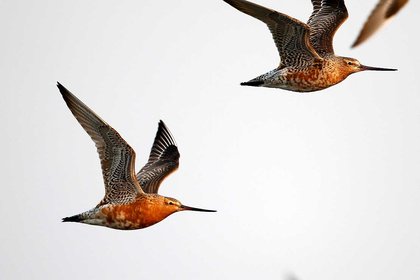
Eighteen birds have been fitted with a small tracking device for the project.
A new research project tracking godwits' journeys from New Zealand to Alaska is hoped to provide information on how they cope with habitat loss, environmental degradation and collapsing food supply in Asia's Yellow Sea region.
The bar-tailed godwit is New Zealand’s most common Arctic migrant and is known for undertaking the annual 18,000km migration from New Zealand to Alaska between March and May. The birds refuel in the Yellow Sea region between mainland China and the Korean peninsula for up to 45 days to recondition before making the last leg of the journey to Alaska to breed. Unlike seabirds, they cannot rest on water or feed at sea, and their 10,000–11,500 km migratory flights are the longest endurance flights undertaken by any bird.
The birds’ population has been declining in New Zealand and Australia over the past four years and this research project aims to understand some of the reasons behind the trend, provide detailed information on the sites godwits are using, and to feed that information back to local researchers. Eighteen birds have been fitted with five-gram tracking devices for this project, which will provide insight into the birds’ behaviour and the impact the Yellow Sea region could have on their future.
Massey University’s Associate Professor in Zoology Phil Battley says the birds are very site faithful, meaning they will likely continue to return to the Yellow Sea region regardless of the food supplies or environmental conditions.
“Already this project has provided amazing insights of how birds deal with the challenges of migration. Three birds had to cope with Cyclone Gretel northeast of Australia. Two managed to push through the headwinds it brought and made it up to Asia. The third fought the winds for 36 hours before bailing out on migration and returning back to New Zealand. 6500 km and 6 days of flight only to be back where it started from.”
Dr Battley says 2011 was a good year for godwits and food supply in the region, but since then, shellfish numbers at the key site in China for godwits have collapsed. Across the whole Yellow Sea region, land management changes, reclamation of mud flats and pollution threaten the ecosystem that shorebirds rely on.
“We want to know how the birds are responding to the changes in habitat there. Will they continue going to the same place and struggle to refuel? Or do they get up and move? We know the collapse of shellfish numbers is putting pressure on migrating birds.”
He says one scenario is that they keep returning each year, but conditions worsen, which could have flow-on effects with their breeding and next year’s production.
The research involves Massey University, The Global Flyway Network, Birds NZ, Bird Studies Canada, and several volunteers with expert assistance from researchers from the Max Plank Institute. With COVID-19 restricting research in Asia, on-ground evaluations will have to wait for another year, but the transmitters should continue to work in a year’s time when the exercise can be repeated.
As of March 25, six godwits have landed in east Asia and researchers are keeping a daily eye on others as they make their week-long flights.
For Dr Battley, who has dedicated much of his career to researching godwits, this project is about building on what they already know.
“These birds are an incredible extreme migrant and are at the edge of what we believe birds are capable of, and they do this really easily.
“Godwits are in New Zealanders’ minds and there’s a long, historical connection to godwits in many places around the country with volunteers and researchers dedicated to helping or knowing more about these birds. People in New Zealand are aware, impressed and they care about these birds.
“We are tracking for conservation more than discovery or science.”
The birds' journey can be tracked at Global Flyway Network.